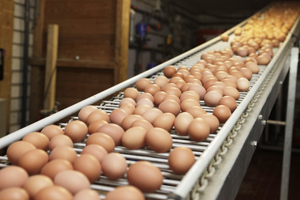Current trends in the US egg industry

The US egg industry is steadily moving forward. In 2013, the total production is expected to increase slightly compared to 2012. Feed costs remain a critical factor. New legislation is also coming closer. An overview with facts and figures.
By Dr Simon M. Shane, Durham, NC, USA
During 2013 the US egg production industry will likely have produced 6.586 billion dozen eggs representing a 1.1% per annum increase since 2010. Hen numbers in the US have remained relatively constrained by the imperative to avoid over-production.
The USDA-National Agriculture Statistics Service recorded an average of 285.1 million hens in 2012 which was approximately 4.8 million more than in 2011. It is estimated by the USDA that there were 284 million hens in flocks over 30,000 representing 98.5% of the US total. The top six states had a combined hen population of 162.7 million in September as noted in Table 1.
Projecting forward, the University of California model predicts that during the proximate 12-month period, hen numbers will range from a seasonal peak of 296 million hens in December 2013 to a low of 290 million hens during September. The national flock will peak in December 2014 at 292 million hens. It is projected that the 2013 US per capita annual consumption will reach 250.7 eggs. The ten top egg producers, as shown in Table 2 ranked by number of hens (rounded to millions), represent 50.0% of total production.
Costs and profitability
The US egg production industry experienced moderate profitability over the first nine months of 2013 attaining a cumulative ex-farm contribution amounting to €0.38 per dozen or a monthly average of 4.2 cents per dozen. The factors which determine the profitability of the US egg production industry are the cost of feed and the magnitude of demand by consumers, which determines price and the quantity of eggs destined for breaking or export. The average numbers of hens and the mean wholesale price posted by a national benchmarking service is shown in Table 3.
The components of ex-farm production cost are depicted in Table 4. Producers generated a margin of 11.2 cents per dozen at farm level corresponding to a profit of 21.5 cents per hen, or across the industry a margin of €95 million for the month. For the first nine months of 2013 cumulative ex-farm contribution amounted to 50.3 cents per dozen.
The cost of feed has been a significant determinant of profitability. Average feed price over five regions surveyed by the USDA attained €249.40 per metric ton (mt) during September. This figure includes ingredients, milling (€7.70 per mt) and delivery (€2.30 per mt). In comparison, average feed cost during 2012 was €267.20 per ton compared to the nine-month average over 2013 to date of €267.05 per mt. Each €10 per ton difference in feed costs represents 0.8 cents per dozen in the US, applying average production parameters.
Projected yield
Future profitability will be influenced both by market realisation and ingredient cost with both sides of the equation determining margin during the fourth quarter of 2013. Both maize and soybean meal prices have declined since the high levels pertained during the first half of 2013, attributed to the severe drought of 2012. The USDA has issued a long-range forecast for the 2013 maize crop of almost 348.0 million mt in the September World Agriculture Supply and Demand Estimate Report. This was based on a projected yield of approximately 9.7 mt per ha. The eventual size and value of the 2013 maize harvest, the nutrient quality of the crop, the possibility of mycotoxin contamination, export demand, diversion to ethanol and hedge-fund trading would all be factors modifying price.
Speciality egg sales
Cal-Maine Foods, the largest enterprise in the US, and the world, with a market capitalisation of €900 million is the only producer to release financial performance as it is structured as a public-traded company. For the 1st quarter of fiscal 2014 Cal-Maine Foods declared net sales of €246 million and net income of €6.7 million. The quarterly report by Cal-Maine Foods demonstrates the beneficial effect of sales of specialty eggs to offset the escalation in the cost of feed ingredients. For this company specialty egg sales attained 16% of volume and 25% of sales value in the most recent quarter. The average selling price of shell eggs for the quarter was €0.96 per dozen but specialty eggs, which incurred incremental costs, averaged €1.53 per dozen representing a premium of 59% over generics.
Depending on the cost of replacement pullets and market conditions, producers in certain areas of the US elect to molt flocks for a second cycle. The proportion of molted hens reached 19% in August and the extent ranges from a high of 33% in the Western states to a low of 7% in the Northeast region.
Products and exports
Approximately 31% of shell eggs produced are further-processed to liquid with the bulk of this volume derived from in-line breaking plants. Exports in both shell and liquid form represented 4.8% of national production in July 2013 with shell egg exports corresponding to 2.4% of total production. Mexico has been a significant importer of eggs with 73% of exported shell products moving across the southern border. The demand for eggs in Mexico results from losses sustained as a result of ongoing highly pathogenic avian influenza.
Facing challenges
The major situation facing the US industry is the need to convert from conventional cages to enriched colony systems. Proposition #2 passed by the electorate of California in November 2008 mandated an imperfectly defined set of requirements for confinement to be introduced in the State by January 1st 2015.
Successive lawsuits have attempted to either overturn Proposition #2 on the basis of vagueness in wording or non-constitutionality. The courts have maintained that Proposition #2 is a legal statute and accordingly the industry must adapt to the new requirements. A number of producers in California have elected to cease production in 2015. Others have converted housing, where suitable, to floor systems with either aviaries or a combination of slats and litter albeit at lower capacity compared to cages.
Some large producers are in the process of converting to enriched modules based on the European design. Alternatively others have decided as a matter of expediency or survival to remove cage partitions in existing installations to allow stocking densities equivalent to the floor area in enriched modules.
To protect the producers who will remain after 2015 from competition from Midwest states using conventional cages, the California Legislature has decreed that all shell eggs imported into California must be produced under conditions conforming to Proposition #2. This provision has been loosely interpreted by the California Department of Food and Agriculture as a predetermined space allowance although there are no provisions for enrichment. This requirement that producers transferring eggs to California must adhere to the stocking density regarded as complying with proposition #2 is likely to be challenged.
The requirement is based on the obviously specious justification of promoting food safety. Individual states cannot create barriers to interstate commerce unless supported by scientifically valid demonstrable health or disease control requirements.
Increased cage space
In 2002 the United Egg Producers, the association representing 90% of the egg industry embarked on a project to engender consumer support based on a certified welfare programme. It was decided to increase cage space for white-feathered hens from approximately 125 cm2 to 170 cm2 per hen over four years. There was a transitory period when producers were expanding to compensate for a decline in house capacity.
A consortium of institutional and food service buyers maintained that the welfare initiative represented collusion to reduce output and to increase the price of eggs. Accordingly a class action lawsuit was entered into the court system which has continued to the present time. Two large producers elected to settle with the claimants, in one case for an undisclosed sum and the other for €22 million. Attaining an eventual stocking density in excess of 300 cm2 per hen will require an additional 40% housing capacity to maintain the current output of eggs.
New regulations
Since the inception of the Food and Drug Administration Salmonella Prevention Program, in July 2011 the US industry has worked hard to conform to the new regulations mandating biosecurity, rodent suppression and monitoring of flocks for environmental Salmonella Enteritidis contamination. Eggs are now maintained at 7°C from the time of packing through the entire distribution chain.
According to data released by the Food and Drug Administration, the prevalence rate of SE is under 2% of flocks and should decline even further during the coming year. At the present time all flocks over 30,000 have been inspected with selected farms assayed by the FDA. The Agency is now turning attention to flocks from 3,000 to 30,000 hens.
There are no outstanding disease problems in the industry. This is due to the absence of vertically transmitted infections. The major hatcheries participate in the National Poultry Improvement Program relating to Salmonella Enteritidis, mycoplasmosis and avian influenza. Erosive diseases are effectively controlled by a combination of vaccination and biosecurity although both these modalities require constant upgrading.
Acquisitions expected
There have been no noteworthy acquisitions in 2013 but it is inevitable that some of the larger companies will purchase the assets and production facilities of less efficient companies. Smaller scale producers are faced with the need to expend capital to convert housing to either floor systems or enriched cage modules. This is in response to an agreement between the Humane Society of the United States, the leading welfare organisation and the United Egg Producers.
Join 31,000+ subscribers
Subscribe to our newsletter to stay updated about all the need-to-know content in the poultry sector, three times a week. Beheer
Beheer








 WP Admin
WP Admin  Bewerk bericht
Bewerk bericht